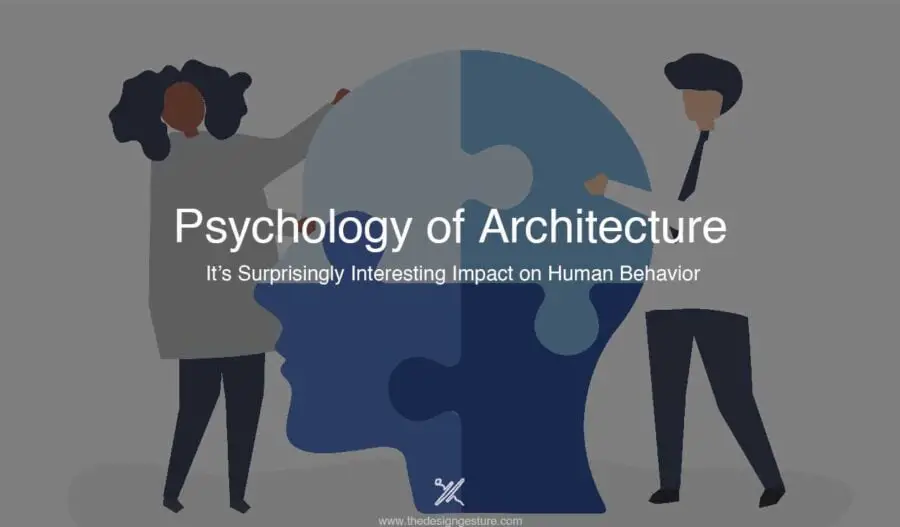Throughout history, architecture has been the essence of richness reflecting values, customs, traditions, region, topography, and civilizations’ rise and fall. From the architecture of ancient civilizations to modern society, the inhabitants had a physical and emotional connection to the space they dwelled in. Human needs evolved so did their need of dwelling. However, the space in which inhabitants dwell affects their psychology and behavior, say researchers in recent times.
Architecture, timely has been an essential part of human life and society. It is an inseparable part of human evolution and humankind. Architecture plays a vital role in shaping human life, whether it be ideas or notions, through perception or experience. Just like a human gets influenced by others similarly, they also get influenced by architecture and design.
Table of Contents
Importance of Architecture
Architecture is an integral part of society. Architecture is in roots. It creates physical spaces for people to dwell in their life experiences, memories, notions, ideas, and aspirations. Architecture is not just a physical entity but it is more than physicality. Ultimately, architecture is a reflection of culture and part of it. It reflects our culture, aspirations, and ourselves too.
The concept of the physical is built in terms of functionality it is pretty simple to create build where people could perform certain activities sufficing their needs. Architecture is this tool but it reflects more of people rather than only being solid. Timely, architecture evolved and now everyone has access to various built forms and learn about them. Every place people go connects them personally with the built.
Architects must expand their boundaries to enhance this experience, memories, and spaces. Architecture influences people at a personal level as well as influences society. Every detail of the space influences people, from layout and placement to furniture material and color. Ar. Zaha Hadid said,
“Architecture is really about well-being. I think that people want to feel good in a space… On the one hand, it’s about shelter, but it is also about pleasure.”
A space that is well-designed and well-functioning, the inhabitant of the same would be happy and enjoy the physicality around, but if the space is not well functioning or not well-designed based on ergonomics or any other factors, the effect could be observed in human behavior and response to the surrounding. Architecture can influence human responses strongly.
The solid concrete mass affects humans negatively, and to have a positive impact on the same, one must alter the approach, materiality, or volume depending upon the context, topography, and functionality. The well-designed space resonates with humans subconsciously. While designing it is important to look at the experience that idea would create as it is equally important, the connection between the physicality and user.
Built and Human Psychology
Human psychology along with architecture is vast and varied to dwell into the depth. The relationship between space and human psychology can be multifaceted and has various influences. People may feel anxiety, sadness, or helplessness as a result of the stress of an uncomfortable situation. Your immune system is subsequently suppressed as a result, which also raises your blood pressure, heart rate, and muscle tension. Positive surroundings change that. Here are two major aspects of this relationship:
Impact of Space on Human Life
The influence of architecture on human psychology is complex and affects numerous areas as it has on social, emotional, and cognitive health. The physical environment, including the spatial layout, aesthetics, and functionality of spaces, can significantly impact human psychology and well-being.
Research suggests that well-designed and well-maintained spaces can have positive effects on mood, concentration, productivity, and overall mental health. Conversely, crowded or poorly designed spaces may lead to stress, anxiety, and decreased cognitive performance. To support and improve human psychological experiences, architects and designers work to create spaces that encourage comfort, productivity, and a sense of kinship with both the built environment and the surrounding natural environment.
Impact of Nature
Exposure to natural environments and elements, such as sunlight, greenery, and open spaces, has been found to have a positive impact on human psychological well-being. The spaces that are not accessible to natural green spaces could be less experiential and hard to connect with the built emotionally at a subconscious level.
Frank Llyod Wright said,” Study Nature, love nature, stay close to nature. It will never fail you.” Access to nature and outdoor spaces reduces depression and several health problems stayed by various research and survey conducted. Spending more time outside and less time on electronics can improve our ability to solve problems and be creative, according to research from the University of Kansas (Atchley, Strayer, & Atchley, 2012).
Built and Personal Space
Humans need personal space, which is the physical and psychological boundary surrounding an individual. Personal space requirements can vary across cultures and individuals, but feeling crowded or having inadequate personal space can lead to discomfort, anxiety, and irritability. Understanding and respecting personal space is crucial for promoting positive social interactions and psychological well-being.
Every human has its own space boundaries that define the level of privacy in human life. It varies from human to human. But the physical boundary with the built environment. The layers of boundaries are intimate space, personal space, social space, and public space at last. All this has its own function and role in human life. Not any space can overlap one another if it does there would be an imbalance in the spaces which would be reflected in human behavior and response to people and surroundings.
The imbalance in the personal space through the architecture of humans would ultimately influence them. Architecture is such an entity that would influence people with their feelings, emotions, notions, and ideas.
Architecture shapes human behavior in order to create a healthy environment for society, form, function, environment, and human character should be indulged together. Expectations are directly addressed by architecture. In order to build a better environment for people architects, people, and other professionals should dwell on the idea and reality.




